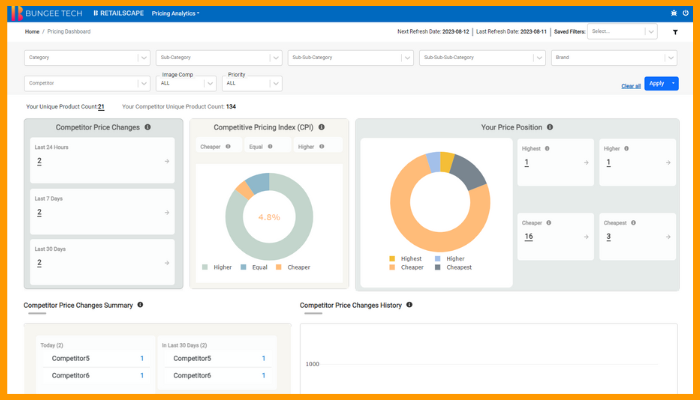Competitor Price Monitoring for Retail Growth
Competitor price monitoring is a key strategy for retailers looking to optimize prices and promotions to increase sales. Competitor price monitoring starts with price intelligence data.
Retailers should have complete visibility into how competitors are setting and changing their prices – on the in-store shelf, on delivery apps, and online. The best way to get this information is through reliable competitive intelligence data which monitors price, promotion, assortment, and availability across channels, across competitors, at whatever frequency needed.
What is Competitor Price Monitoring?
Competitor price monitoring is an essential strategy for successful retail businesses. How it works: Track and analyze the prices of comparable products and categories offered by your competitors.
Competitor price monitoring helps retailers understand how other stores in the market are pricing their offerings and how those prices change over time. Price monitoring helps you see rivals’ pricing strategies so you can adjust your own prices to remain competitive.
With competitive pricing data, retailers gain visibility into market dynamics, trends, and competitive positioning. Most retailers use competitor price monitoring as a strategic advantage to optimize conversions and maximize competitiveness.
What is Price Intelligence?
Price intelligence is broader than competitor price monitoring.
Not only does price intelligence monitor competitor prices, but it also includes gathering and analyzing a wide range of pricing-related data, market trends, and other relevant information. The process of price intelligence is to provide a complete understanding of the entire pricing landscape… beyond just competitor prices.
What is Price Optimization?
Price optimization, on the other hand, refers to the process of using data-driven methodologies, algorithms, and insights (which can be derived from price intelligence) to determine the most strategic and profitable pricing points for products.
This dynamic approach ensures that prices are set in alignment with demand, elasticity, and other external factors.
Price. Price. Price.
All of this to say… price matters in retail.
Let’s recap:
- Competitor price monitoring is a subset of price intelligence
- Price intelligence takes into account a wider array of data and insights to inform pricing strategies
- Price optimization develops optimized pricing strategies
- Retailers need reliable price and promotion data to understand the market and make informed pricing decisions

Collection & Analysis of Competitor Pricing Data
Now, it’s time to get started with your competitive price monitoring & intelligence strategy.
You might think about visiting your competitors’ websites and building a spreadsheet with product details and prices… but that would be incredibly laborious. I know it’s not uncommon for retailers to comp shop by sending employees into competitor stores to check out what promotions are running and take notes on pricing… but that’s not scalable.
The best way to collect and analyze pricing data starts with competitive intelligence. A credible retail competitive intelligence provider has a proven data collection method – whether online or in-store – so that you’re receiving the data frequently, reliably, and you trust its accuracy. Once the data has been collected, then your comp intel provider should match products so that you can easily compare exact, equivalent, and similar products across the competitive market. Like data collection, product matching shouldn’t be a manual process. Once the product matches are available, you can analyze the pricing/promotion data to make more informed decisions on your growth strategies.
Pricing Data In Action
Prices are dynamic, and some retailers change them quickly and often (👀 Amazon). To compete, you really need that pricing intelligence component so that you can confidently set the right price.
Before you leverage your price data, retailers should define their key value items (KVIs) and competitors (whether a traditional retailer, pureplay ecommerce, or omnichannel player).
Now, you can monitor the prices and promotions for these items and stores closely. Analyze the data to find strategic ways to compete on pricing with your biggest rivals.
Even if you want to be positioned as the price leader to increase loyalty and sales, that doesn’t necessarily mean dropping your prices… To standout, you have to offer a strong price-value to promote and drive the purchase decision.
I recently looked at some data for a specific retail vertical and noticed that one retailer’s prices were regularly 20% lower than the competitive set. The advice there is to actually raise the certain items prices to match the market trends.
To capture pricing data or discover your competition, look for a retail-specific competitive intelligence platform. (Talk to us if you’re looking for a scalable, reliable process.)
5 Benefits of Price Intelligence
Monitor Competitor Price Strategies
Track prices and promotions across the competitive landscape. Imagine having the visibility of the highest priced retailers, the lowest priced retailers, and exactly where you fit.
Gain Efficiency & Drive Innovation
Focus on your strategy by leveraging a price intelligence / competitive intelligence solution. No more manual collecting, auditing or cleansing your data to get a picture of the market. Your provider should stitch a real time picture for you.
Improve Your Assortment Strategy
Identify assortment gaps by comparing your catalog to competitor catalogs. With reliable data, you can notice if a category or item is regularly discounted and draw a conclusion that that category or item may be growing sales for your competitor.
Build Customer Loyalty
Develop your pricing strategy around price perception. If your prices are too high, some shoppers may avoid your store altogether. If your prices are too low, some shoppers might consider your selection low quality. The sweet spot is building loyalty so that shopper has a strong perception of your prices.
Strengthen Your Pricing Strategy
Use all of the data, product matching, and analytics from a retail pricing intelligence solution to drive sales. Monitor and analyze the competitive landscape so that you can optimize your prices instead of copying and pasting your strategy year after year.

Does Everyone Love a Bargain?
Shoppers are price sensitive and notice price changes.
More than 263 million American consumers shop online—some 80% of the population—and you can expect this number to climb to 291.2 million by 2025.
But, don’t ignore in-store shopping. Customers expect a seamless online to in-store buying experience. For example, some 70% of shoppers factor in the availability of physical stores when buying.
This means the omnichannel experience is a critical component to success. Retailers should nurture all shoppers throughout the buying journey to boost value perception. Every retailer needs consistent pricing, promotions, and availability between your online storefront and physical brick-and-mortar shelves.
Set Up Your Own Competitor Price Tracking
Get reliable, accurate pricing intelligence to stay a step ahead of your competition. Tell us what competitors, SKUs, and zip codes you’d like to monitor and we’ll show you how competitive pricing data will help your business grow. Click here to opt-in for a free trial 👉




